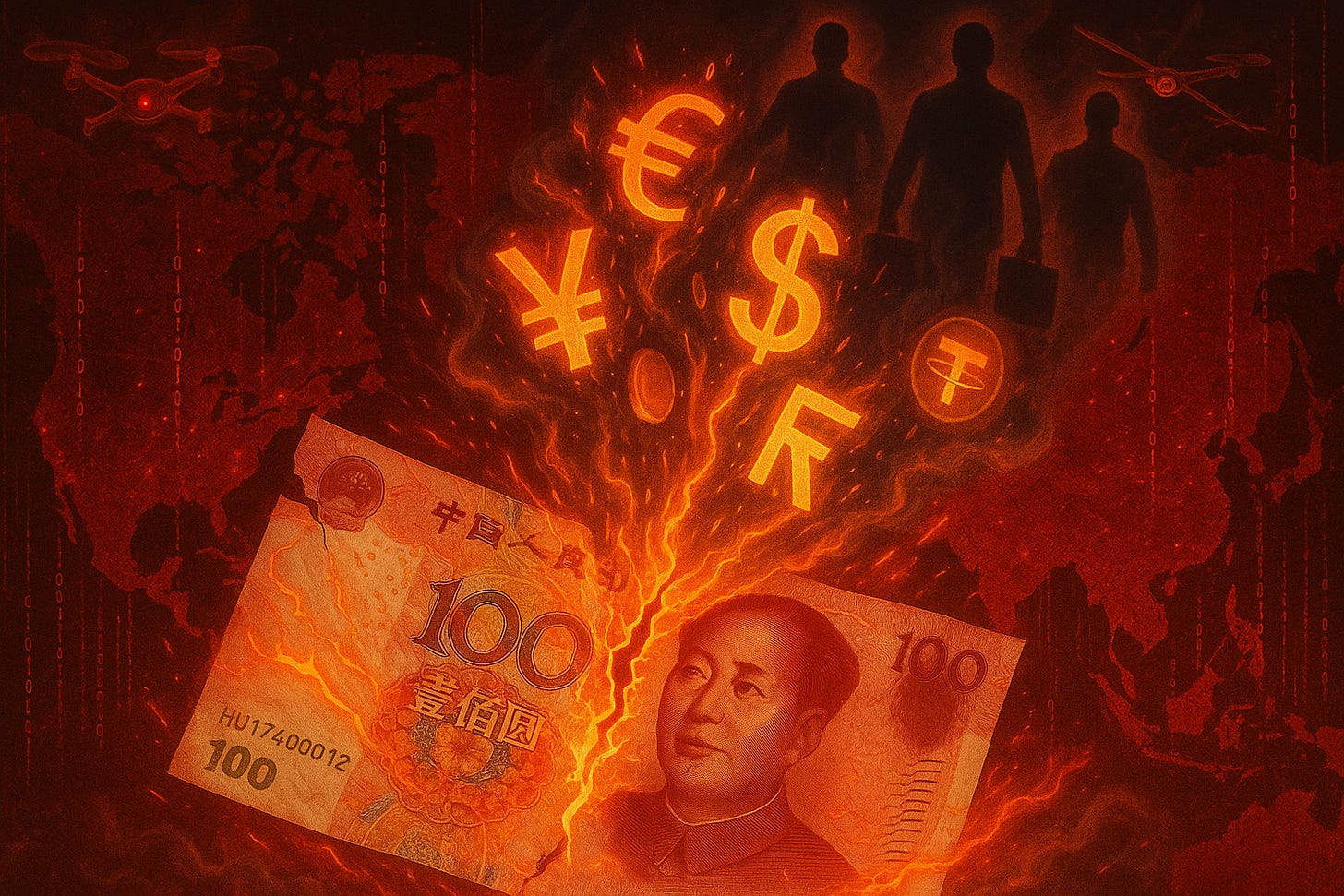Today we’re featuring Between the Lines.
Most news skims the surface. Between the Lines digs underneath.
Adam doesn’t chase clicks. He studies risk—real risk. The kind that shapes markets, tech, warfare, and global decisions. His work connects dots others don’t even see.
If you care about what’s really coming down the line—not just headlines—this is worth a read!
I’ll let Between the Lines take over from here…
China’s Gray Zone Syndicates
A three-part investigative series on how China’s shadow financial ecosystem has evolved — from a sanctions buffer into a global risk network.
By Adam Rousselle, Chief Analyst at Between the Lines
Why you should read this series
Unpacks Beijing’s evolving strategy: Originally designed to shield China from Western pressure, gray-zone financial tactics have fractured into decentralised, self-sustaining criminal networks.
Explains hidden geopolitical feedback loops: How shadow reserves spilled into Southeast Asian SEZs, casino hubs, and scam centers, fueling regional crime economies that now threaten global financial stability.
Maps the fallout for the West: From Canadian real-estate distortions to U.S. crypto AML risks, and European exposure to opaque SEA-capital corridors.
Powered by forensic finance and first-hand experience: Featuring sources from Elliptic, Chainalysis, Nikkei, ASPI, UNODC, diplomatic cables, and leaked Telegram logs. These combined with Adam’s near decade-long experience in China and Southeast Asia provide invaluable insights into this complex emerging global threat.
Series Overview
Part I - Criminal Convergence: How informal criminal networks became a weapon of Chinese statecraft
Part II - The Reversal: How shadow reserves and capital outflows now threaten Beijing and wreak havoc around the world
Part III - Connected Heat: Risks to global markets and long-term threats to China’s internal cohesion
Subscribe to stay tuned
Get each installment delivered straight to your inbox. Paid subscribers receive early access, audio readings, source documents, and subscriber Q&As.
Up Next: Part III — Connected Heat
Coming This Week – Paid Subscribers Only
In Part I: Criminal Convergence, we traced how China began leveraging transnational criminal ecosystems—scam syndicates, offshore gambling hubs, and laundering proxies—to extend its influence across Southeast Asia. These networks, often dismissed as local or incidental, were in fact strategic infrastructure: designed to operate below the threshold of formal conflict, with just enough distance to maintain plausible deniability. Perfect for avoiding tariffs and even sanctions.
Part II: The Reversal exposed how China’s shadow financial system—initially built to insulate against sanctions and capital flight—has begun to splinter from within. As informal liquidity spread beyond Beijing’s control, regional SOEs, PLA-linked firms, and elite actors started improvising with gray-market tools. The result? Strategic ambiguity gave way to strategic disunity, echoing historic periods of Chinese decentralization and internal fiscal fracture.
Now, in Part III: Connected Heat, we turn to the global blowback.
Western institutions—from crypto OTC desks in Colorado to property markets in Toronto and regulatory blind spots in Europe—are increasingly entangled in this gray-zone ecosystem. Stablecoins laundered through Southeast Asia. Chinese capital embedded in real estate-backed securities. European banks onboarding affiliates linked to underground financial rails.
China tried to build a sanctions buffer. Instead, it built a heat trap. And now it’s leaking into the global system.
This final installment explores how a system designed for Chinese resilience may end up destabilizing the very global markets it depends on—and how the next financial shock may come from a node no one is watching.
What other readers are saying
"Timely and illuminating + the fact that The Economist seems to get some inspiration from Between the Lines"
“It’s refreshing to find real news and information. Especially, in a clear and direct format with little to no ideological tarnish.”
“Searching for alternative sources of information to get details and peel back layers of the story. It is difficult to figure out what is happening and other parts of my life demand much of my time.”
“The professional presentation, diversity of material, and depth of coverage on national security topics by the 'Between the Lines' team is top tier. It reads like finished intel product, and when I open the 'Between the Lines' emails, I feel like I am getting my own PDB.”
About the Author
Adam Rousselle is the founder and chief analyst at Between the Lines, an independent research platform focused on illicit finance, dual-use technology, and geopolitical risk.
He has lived and worked in China and Southeast Asia for over eight years, with on-the-ground experience in commodities analysis, shadow economies, and political risk forecasting. His work has appeared in publications such as Nikkei Asia, The Wall Street Journal, and across multiple think tanks and investigative research outlets.
Through Between the Lines, he tracks the dark intersections of power, capital, and conflict—mapping what others miss.
Quick links
Nothing in this email is intended to serve as financial advice. Do your own research.









